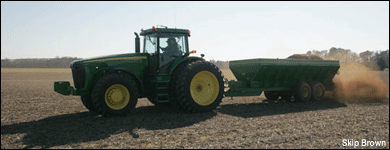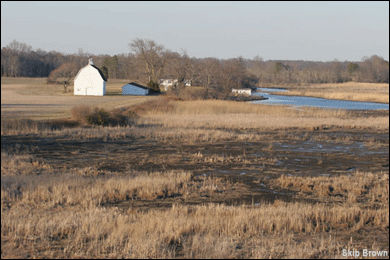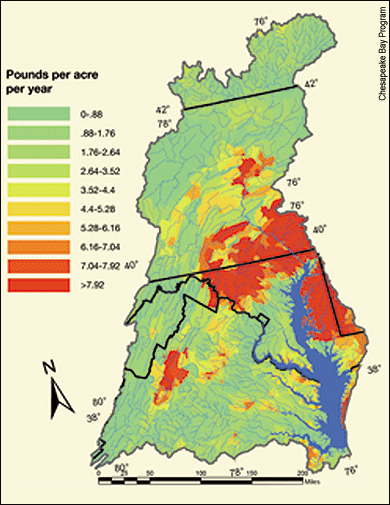Photograph: Farmer Balvin Brinsfield and his son Josh work a field on their farm near the Nanticoke River in early spring. Photograph by Skip Brown.
Contents
Coastal Populations
Swell Nationwide

By Jack Greer
A sharp west wind sings across the flat fields of Balvin Brinsfield's farm, just north of Vienna, Maryland. The wind has the bite of winter in it, but otherwise the sun is shining and the low-lying fields gleam with a thin carpet of green. Balvin has a wide smile and a welcoming handshake. Welcome to farm country, Eastern Shore style.
To get here, drive east and south from Annapolis for an hour and a half to the marshy Nanticoke River, where traffic thins out and life slows down. Turn north onto Route 331 just past a sign that says, Scenic Byway: Chesapeake Country. In the middle of a winter's morning you might stand on the centerline of the road and not see a car coming either way. But despite this rural quiet, there is a double message in Balvin Brinsfield's handshake and that scenic highway sign: this is both farm country and Bay country, a landscape that offers up sweet corn, peppers and soybeans, but also blue crabs, oysters and striped bass. When things are working right, it is a bountiful place to be.
Brinsfield has a round face and looks at you with clear eyes. It is a farmer's face, and you can see those same features in his ten-year-old son, Josh. Brinsfield seems a modest man, with no axes to grind. Still, working the land has its challenges, and changing weather, changing markets, and changing regulations routinely test his patience.
Cranking up the heat in one of his sheds on a cold February morning, he sits down to talk about farming. Soon his cousin John Brinsfield, who lives next-door, comes in and joins the conversation. The Brinsfields have been here since grandfather Balvin Bacchus Brinsfield settled this low-lying Eastern Shore land three quarters of a century ago.
In addition to difficult markets and narrow profit margins, farmers must also contend with a range of programs aimed at cleaning up the Chesapeake Bay.
Both Balvin and John each farm fewer than 400 acres. In fact John shares his land with other members of his family, so they have three families supported by a little more than 100 acres each. Between Balvin and John's farms they grow sweet corn, feed corn, soybeans and assorted vegetables — string beans, peppers and onions. Depending on the year, Balvin may also grow watermelon, potatoes and pumpkins. While the vegetables are headed for market (or Balvin's roadside stand), the feed corn is usually headed for poultry houses — part of a large Eastern Shore connection between grain crops and a very big chicken business.
The Brinsfield compound represents a tiny slice of the estimated 87,000 farms in the Chesapeake Bay watershed — most of which average only about 180 acres, far smaller than the 500-acre average for the rest of the country. While large agricultural companies may get the press, the vast majority of farmland in this region is still comprised — so far — of fairly small family-owned farms.
The two Brinsfield cousins make it clear that farming is part of who they are. "We sure aren't in it because it's lucrative," John laughs, dragging out the word lu-cra-tive. John has penetrating brown eyes and a college diploma, and like Balvin, he takes his farming seriously.
Perhaps their biggest concern is what John calls "succession" — the passing on of the family farm. Fewer farm children want to stay on the farm, John says, given the demanding lifestyle and the market's economic rollercoaster, and he sees smaller farms taken over by increasingly larger ones. Grandfather Balvin Bacchus Brinsfield left his farm to his children and grandchildren, but John worries about what will happen to family farms all across the Bay region once the current generation passes away.
Ten-year-old Josh, home schooled and attentive to this conversation, says with a shy smile that he'd like to work the farm — and maybe he will.
If he does, he will inherit not only the land but the tensions of an ongoing dilemma. He will face the dual challenge of working the farm while protecting the water, of keeping this land along the Nanticoke both farm country and Bay country.
Balvin and John say that they care about the nearby Nanticoke River, where they sometimes fish and where John likes to sail and kayak. The cousins take pride in their farms, and they are often unhappy with the way farmers are portrayed in the media. The talk about "all these subsidies" farmers are getting. Balvin tugs at the bill of his cap and says he would rather just get paid for his crops and not have to worry about subsidies at all.
This is a painful irony, that farmers, who as a group don't generally like big government, often rely on government subsidies.
And it gets more complicated than that.
The state of Maryland, the federal government and the environmental community are all calling on farmers to help clean up the Chesapeake Bay. In addition to difficult markets and narrow profit margins, farmers now contend with a range of Bay-related programs — cover crops, nutrient management plans, manure management, buffer strips and easements, among others.
This is because farming, according to the regionwide Chesapeake Bay Program, puts more pounds of nitrogen, phosphorus and sediment into creeks, rivers and the Bay than any other source — some 40 percent of the nitrogen and phosphorus and more than 60 percent of the sediment.
While about half of agriculture's flow of nitrogen and phosphorus comes from intensive animal operations, especially poultry, the other half comes from chemical fertilizer used on a variety of crops. Sediment comes from a wide range of row crops and farm activities. A recent report by the Chesapeake Bay Watershed Blue Ribbon Finance Panel (see "Desperately Seeking Dollars") has stated that in order to reach goals for restoring the Bay virtually all of the region's 87,000 farms will need to implement improved farming and conservation techniques — generally known as best management practices (BMPs) — at levels never before seen in this country.
Come spring, Balvin will walk over to the long sheds covered by corrugated roofs and start up a large machine he uses to spray herbicides and fertilizers, or he'll pull out a tractor to disk the fields and turn over the topsoil, as farmers have done for generations. If he decides on no-till farming, a widely used practice that prevents soil erosion by cultivating crops without overturning the soil, he'll have to use herbicides to burn off cover crops or weeds. If he disks his fields to turn over the soil and activate nitrogen-fixing bacteria, he'll risk more erosion. If he spreads manure but doesn't disk it in, the manure will volatilize, with ammonia evaporating into the atmosphere and then raining down to add to the region's nitrogen load.
There is a lot for a farmer to think about in Bay country.
Along the Nanticoke, farmland blends into marshland (top, by Skip Brown). Farms have bordered the Bay since before George Washington built Mount Vernon on the Potomac, but intensive agriculture has led to a surge of nutrients that find their way into the Bay's rivers and streams (bottom, Chesapeake Bay Program).

